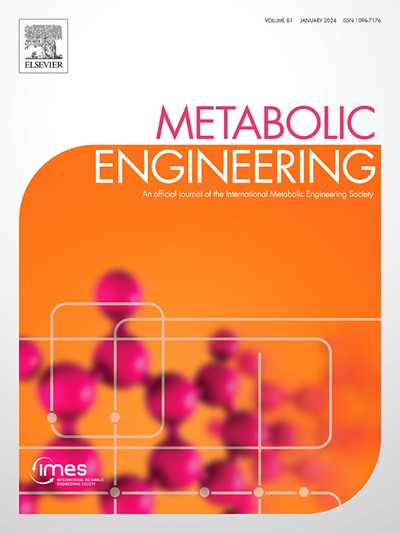Adaptive laboratory evolution and genetic engineering improved terephthalate utilization in Pseudomonas putida KT2440
IF 6.8
1区 生物学
Q1 BIOTECHNOLOGY & APPLIED MICROBIOLOGY
引用次数: 0
Abstract
Poly (ethylene terephthalate) (PET) is one of the most ubiquitous plastics and can be depolymerized through biological and chemo-catalytic routes to its constituent monomers, terephthalic acid (TPA) and ethylene glycol (EG). TPA and EG can be re-synthesized into PET for closed-loop recycling or microbially converted into higher-value products for open-loop recycling. Here, we expand on our previous efforts engineering and applying Pseudomonas putida KT2440 for PET conversion by employing adaptive laboratory evolution (ALE) to improve TPA catabolism. Three P. putida strains with varying degrees of metabolic engineering for EG catabolism underwent an automation-enabled ALE campaign on TPA, a TPA and EG mixture, and glucose as a control. ALE increased the growth rate on TPA and TPA-EG mixtures by 4.1- and 3.5-fold, respectively, in approximately 350 generations. Evolved isolates were collected at the midpoints and endpoints of 39 independent ALE experiments, and growth rates were increased by 0.15 and 0.20 h−1 on TPA and a TPA-EG, respectively, in the best performing isolates. Whole-genome re-sequencing identified multiple converged mutations, including loss-of-function mutations to global regulators gacS, gacA, and turA along with large duplication and intergenic deletion events that impacted the heterologously-expressed tphABII catabolic genes. Reverse engineering of these targets confirmed causality, and a strain with all three regulators deleted and second copies of tphABII and tpaK displayed improved TPA utilization compared to the base strain. Taken together, an iterative strain engineering process involving heterologous pathway engineering, ALE, whole genome sequencing, and genome editing identified five genetic interventions that improve P. putida growth on TPA, aimed at developing enhanced whole-cell biocatalysts for PET upcycling.

适应性实验室进化和基因工程改善恶臭假单胞菌KT2440对对苯二甲酸酯的利用。
聚对苯二甲酸乙酯(PET)是最普遍存在的塑料之一,可以通过生物和化学催化途径解聚成其组成单体,对苯二甲酸(TPA)和乙二醇(EG)。TPA和EG可以再合成成PET进行闭环回收,或者通过微生物转化成高价值产品进行开环回收。在这里,我们扩展了我们之前的工作,工程和应用恶臭假单胞菌KT2440通过适应性实验室进化(ALE)来改善TPA的分解代谢,使PET转化。三株具有不同程度EG分解代谢工程的恶臭杆菌菌株在TPA、TPA和EG混合物以及葡萄糖作为对照上进行了自动化的ALE运动。ALE使TPA和TPA- eg混合物的生长速率分别提高了4.1倍和3.5倍,约为350代。在39个独立ALE实验的中点和终点收集进化菌株,在TPA和TPA- eg上生长速度分别提高0.15和0.20 h-1。全基因组重测序鉴定出多个聚合突变,包括全球调控因子gacS、gacA和turA的功能缺失突变,以及影响异源表达的tphABII分解代谢基因的大量重复和基因间缺失事件。这些靶点的逆向工程证实了因果关系,与基础菌株相比,删除所有三个调节因子的菌株和tphABII和tpaK的第二拷贝显示出更高的TPA利用率。总之,一个涉及异源途径工程、ALE、全基因组测序和基因组编辑的迭代菌株工程过程确定了五种基因干预措施,可以改善恶臭杆菌在TPA上的生长,旨在开发用于PET升级回收的增强全细胞生物催化剂。
本文章由计算机程序翻译,如有差异,请以英文原文为准。
求助全文
约1分钟内获得全文
求助全文
来源期刊

Metabolic engineering
工程技术-生物工程与应用微生物
CiteScore
15.60
自引率
6.00%
发文量
140
审稿时长
44 days
期刊介绍:
Metabolic Engineering (MBE) is a journal that focuses on publishing original research papers on the directed modulation of metabolic pathways for metabolite overproduction or the enhancement of cellular properties. It welcomes papers that describe the engineering of native pathways and the synthesis of heterologous pathways to convert microorganisms into microbial cell factories. The journal covers experimental, computational, and modeling approaches for understanding metabolic pathways and manipulating them through genetic, media, or environmental means. Effective exploration of metabolic pathways necessitates the use of molecular biology and biochemistry methods, as well as engineering techniques for modeling and data analysis. MBE serves as a platform for interdisciplinary research in fields such as biochemistry, molecular biology, applied microbiology, cellular physiology, cellular nutrition in health and disease, and biochemical engineering. The journal publishes various types of papers, including original research papers and review papers. It is indexed and abstracted in databases such as Scopus, Embase, EMBiology, Current Contents - Life Sciences and Clinical Medicine, Science Citation Index, PubMed/Medline, CAS and Biotechnology Citation Index.
 求助内容:
求助内容: 应助结果提醒方式:
应助结果提醒方式:


